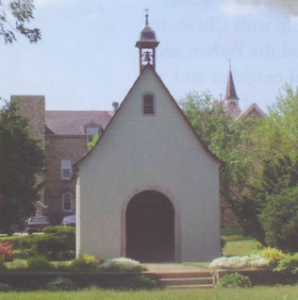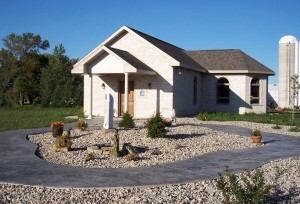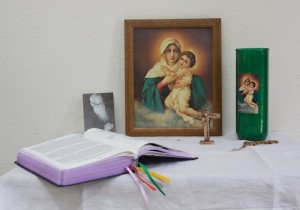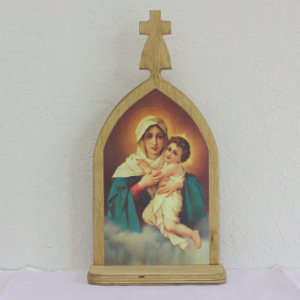History of Schoenstatt
What is Schoenstatt?
Schoenstatt is a Catholic ecclesial movement that strives to live the Gospel of Jesus Christ through the example and guidance of Mary. Schoenstatt was founded on October 18th, 1914, by Fr. Joseph Kentenich in the little Schoenstatt valley in the Rhine region of west-central Germany. The word Schoenstatt” comes from the German for “beautiful” (schon) and “place” (statt). Schoenstatt is deeply and devotedly Marian and has repeatedly experienced how love of Mary opens new avenues to a vibrant relationship with Christ, to the HOly Spirit, to God the Father, and to a renewal of love of neighbor and self. Not least of all, love of Mary has helped many grow in love for the church. This is in keeping with Pope John Paul II’s message to the Schoenstatt Family during an audience in 1985, where he said: “An authentic Marian spirituality leads to a deep love for the Church.”
A Movement of Moral and Religious Renewal
As a movement of moral and religious renewal in the Catholic Church, Schoenstatt works to help renew the Church and society in the spirit of the Gospel. It seks to reconnect faith with daily life, especially through a deep love of Mary, the Mother of God. As an international movement it is present on all continents and has members from all vocations and walks of life. It is a spiritual family whose many branches and communities join to form a single Schoenstatt Family.
A Place of Grace
As a place of grace, Schoenstatt has touched the lives of millions. The Schoenstatt Shrine is the movement’s spiritual home and center of life. The shrine is dedicated to Mary as the Mother Thrice Admirable, Queen, and Victress of Schoenstatt. In addition to the original shrine in Germany, there are over 180 replica daughter shrines around the world where people gather for prayer, renewal, and inspiration.
The shrine is dedicated to Mary as the Mother Thrice Admirable, Queen, and Victress of Schoenstatt. In addition to the original shrine in Germany, there are over 180 replica daughter shrines around the world where people gather for prayer, renewal, and inspiration.
Schoenstatt’s message of mission consciousness is rooted in the conviction that the experience of a place of grace like Schoenstatt inspires us to live the Gospel. Our love for this place of grace helps us actively renew the Church and world.
The Founder: Father Joseph Kentenich
Fr. Joseph Kentenich was born in Gymnich near Cologne, Germany on November 18th, 1885. He began his priestly life as a gifted teacher and educator in the Pallottine House of Studies in Schoenstatt, Vallendar. An extradorinary bond of trust developed between him and his students. They made his love for Mary their own and through his message learned to see her as a bridge leading to a deep, fervent love of God. Alert to the signs of the time and listening attentively in order to perceive God’s will, Fr. Kentenich – together with a small group of students – entered into a covenant of love with Mary in the chapel (now known as the Original Shrine) at Schoenstatt. This was the beginning and the lasting foundation of today’s worldwide development of the Schoenstatt Movement.
Throughout his life as foudnder, Fr. Kentenich gave his followers a deep experience of God’s fatherhood and led them into his own profound love for the Church. On September 15th, 1968, the Feast of the Seven Sorrows of Our Lady, immediately after celebrating the holy sacrifice of the Mass, Fr. Kentenich was called home to the Heavenly Father. At his request, the words Dilexit Ecclesiam (He loved the Church) were inscribed on his tomb.
Shrines of Schoenstatt
The original shrine of Schoenstatt, Germany was initiated on October 18th, 1914 when Father Joseph Kentenich and the seminarians sealed a Covenant of Love with Mary, to establish a personal relationship with Mary and her Son. Through this Covenant, the participants ask the Mother of Jesus to lead us to her Son, Jesus, who in turn leads the covenant partners into a personal relationship with God the Father.
Daughter Shrines
About 180 replica daughter shrines exist throughout the world. There are three pilgrimage graces received in visiting the original shrine or a daughter shrine: the grace of home, the grace of transformation and the frace of apostolic zeal. The shrines are centers of prayer and activity in areas where the ecclesial movement of Schoenstatt is well established. There are four Daughter Shrines in Wisconsin. The first shrine in the United States is based in the Diocese of Madison while the other three shrines are located in the Archdiocese of Milwaukee
Wayside Shrines
Wayside Shrines are built in areas where the Schoenstatt spirituality is in the process of new growth. Many of the daughter shrines spring forth from areas that originally established a Wayside Shrine. Courses on Schoenstatt’s Covenant Spirituality, Instrument Spirituality and Everyday Sanctity provide a sound  foundation in a spiritual life that fosters the three charisms of Family, Eucharistic devotion and Marian practical spirituality. In Marian spirituality, the Blessed Mother educates members in fostering a personal relationship with the Father, Son and Holy Spirit. The Schoenstatt Wayside Shrine Refuge of Sinners is located in the Green Bay Diocese of northeastern Wisconsin.
foundation in a spiritual life that fosters the three charisms of Family, Eucharistic devotion and Marian practical spirituality. In Marian spirituality, the Blessed Mother educates members in fostering a personal relationship with the Father, Son and Holy Spirit. The Schoenstatt Wayside Shrine Refuge of Sinners is located in the Green Bay Diocese of northeastern Wisconsin.
Home Shrines
A home shrine is a prayer corner or prayer room with a crucifix and a picture of the Blessed Mother holding her Son, under the title of Mother Thrice Admirable. This title of the Blessed Mother honors Mary as the Mother of God, Mother of the Redeemer and Mother of the Redeemed.  As with other shrines, Our Lady is invited to enter the home shrine and the three graces of home, transformation and apostolic zeal flow from the home shrine. This sets these shrines up as pilgrim places of grace. The Marian pilgrim sites of Schoenstatt are not based on apparitions like a majority of Marian Shrines. It is by invitation that Our Lady Queen and Victress of Schoenstatt enters the shrine and bestows graces of moral and spiritual transformation.
As with other shrines, Our Lady is invited to enter the home shrine and the three graces of home, transformation and apostolic zeal flow from the home shrine. This sets these shrines up as pilgrim places of grace. The Marian pilgrim sites of Schoenstatt are not based on apparitions like a majority of Marian Shrines. It is by invitation that Our Lady Queen and Victress of Schoenstatt enters the shrine and bestows graces of moral and spiritual transformation.
The Pilgrim Shrine
The traveling pilgrim shrines fostered by the Schoenstatt Rosary Campaign began as a means of allowing the Blessed Mother to visit people in those areas where a shrine is not available. The Pilgrim MTA shrines rotate from one family to another or members may take them on visits to homes, schools, work places, hospitals and nursing homes. Just as Mary visited her cousin Elizabeth in time of need, a presence of Mary accompanies the portable MTA shrine enabling the Blessed Mother to make a pilgrimage to those unable to visit her. As the pilgrim shrine visits the home or work place, the faithful invite the Blessed Mother to enter in and live amongst them for a while. This form of pilgrimage underscores the importance of inviting the Blessed Mother into one’s daily life. It is by invitation that Our Lady bestows the pilgrim graces of moral and spiritual transformation to anyone, just for the asking.
rotate from one family to another or members may take them on visits to homes, schools, work places, hospitals and nursing homes. Just as Mary visited her cousin Elizabeth in time of need, a presence of Mary accompanies the portable MTA shrine enabling the Blessed Mother to make a pilgrimage to those unable to visit her. As the pilgrim shrine visits the home or work place, the faithful invite the Blessed Mother to enter in and live amongst them for a while. This form of pilgrimage underscores the importance of inviting the Blessed Mother into one’s daily life. It is by invitation that Our Lady bestows the pilgrim graces of moral and spiritual transformation to anyone, just for the asking.